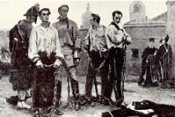
Supreme Criminal Court on Decembrists’ case established
1 (13) June 1826 Nicholas I signed the Manifesto on the establishment of the Supreme Criminal Court for judging the Decembrists. The official name of this extraordinary trial - Highly established Supreme Criminal Court to judge criminals, who revealed themselves December 14, 1825.
The Supreme Criminal Court - the highest extraordinary judicial body of the Russian Empire - was not a permanent institution. It was created in each particular case for consideration of especially important state affairs (the case of V. Ya. Mirovich (1764), the trial of members of the "Plague Riot" (1771), the case of Pugachev and his associates (1774) and so on).
The High Criminal Court for the Decembrists operated from 3 (15) June to 12 (24) July 1826. In accordance with the Decree of 1 (13) June 1826 the Court included representatives of the three "state classes" – 18 members of the State Council (including M. M. Speransky and N. S. Mordvinov); 36 members of the Senate and three members of the Synod; 15 representatives of top military and civilian officials. The Chairman of the Supreme Criminal Court was Prince V. P. Lopukhin, Vice-Chairman - Prince A. B. Kurakin, the duties of Attorney General were performed by the Minister of Justice, Prince D. I. Lobanov-Rostovsky.
Three Committees were established under the Court:
- The Audit Committee (in operation from 7 (19) to 10 (22) June 1826 consisting of 9 persons) in order to control investigation questioned the accused regarding three points: "1. Whether a testimony was signed by the accused himself; 2. Was it signed voluntarily; 3. Was the accused given confrontations";
- The Category Committee - committee appointed by the High Criminal Court to establish categories for different degrees of guilt (in operation from 10 (22) to 27 June (July 9) 1826 consisting of 9 persons) distributed all those brought to trial among 11 categories according to their degree of culpability;
- The Committee for the compilation of the sentence (in operation from 7 (19) to 8 (20) July 1826 included M. M. Speransky (representing the State Council), N. M. Borozdin (representing specially designated civilian and military) and A. V. Kazadaev (representing the Senate)) produced a "Most loyal report of the High criminal Court" and attached to it "Instruction to state criminals sentenced to various punishments and executions by the Supreme Criminal Court."
10 (22) July was signed a decree easing the plight of prisoners of rank 1 to 11. The final sentence in the case of the five Decembrists set out beyond the ranks, was delivered by the Supreme Criminal Court 11 (23) July 1826.
12 (24) July 1826 at the last meeting of the High Criminal Court the verdict was announced to the defendants, and 13 (25) July 1826 it was carried out.
The High Criminal Court ceased its operations in accordance with the "Manifesto on executing a sentence against state criminals" of 13 (25) July 1826.
Lit.: Боленко К. Г. Верховный уголовный суд в системе российских судебных учреждений первой половины XIX века. Автореферат дис. ... канд. ист. наук. М., 2009; Боленко К. Г., Долгих Е. В., Самовер Н. В. К вопросу о борьбе мнений на заседаниях Верховного уголовного суда над декабристами (1826) // Россия и реформы. Вып. 4. М., 1997; Верховный уголовный суд над злоумышленниками, учрежденный по высочайшему манифесту, 1-го июня 1826 года. СПб., 1826; Мироненко С. В. , Селиванова С. А., Фёдоров В. А. Восстание декабристов. Т. XVII. М., 1980; Фёдоров В. А. Своей судьбой гордимся мы… М., 1985; Павлов-Сильванский Н. П. Декабрист Пестель перед Верховным уголовным судом. Ростов н/Д., 1907; Слободянюк И. П. Верховный уголовный суд над декабристами. М., 2005.
Based on the Presidential Library’s materials:

